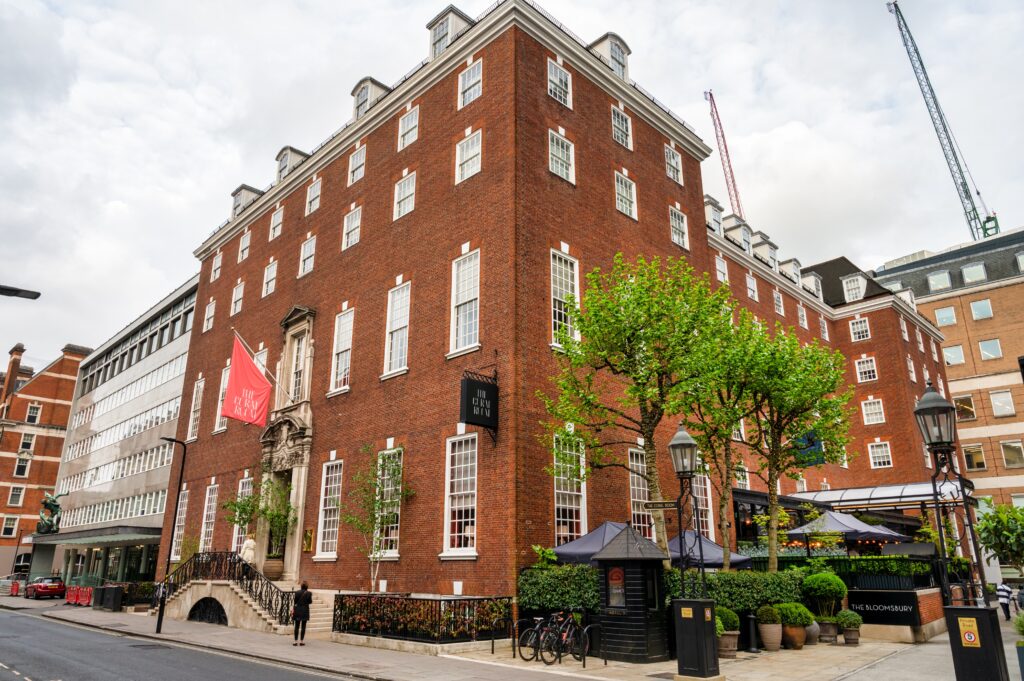Is this a secret hotel in the heart of London – not when you have read this!
Based on the exterior of a Doll’s House designed by Sir Edwin Lutyens for Queen Mary in 1928, the Bloomsbury was once The Young Women’s Christian Association (YWCA). Home to the Bloomsbury set and visited by Princesses Elizabeth and Margaret for a self-service tea in 1939, this central London hotel is even more accessible since the opening of the Elizabeth Line which is within walking distance to Tottenham Court Road and Oxford Street.
Having gone through a multimillion-pound renovation by Martin Brudnizki adding quirky touches by combining Art Deco style with rich soft furnishings and eye-catching wallpapers – think life size birds in gilded cages. Although some may say it looks garish, I think it actually makes a statement which is not out of place in this building.
The redevelopment includes new luxury studio suites, a snug sitting room off the main Reception area, 2 ballrooms, various meeting rooms, gym in the basement, Coral Room, Grand Salon Bar and the infamous and most Instagram able restaurant in London.
The beautiful Coral Room with a 1920’s vibe showcases a marble bar and five bespoke Murano glass chandeliers which illuminate the vivid coral colour walls and artwork commissioned in collaboration with illustrator Luke Edward Hall, all of which are inspired by the local area. Serving a variety of English wines (other countries are available) in a glamorous setting this must rate and in the top 10 bars to go to in London plus free snacks!
The Seamus Heaney Library named after the Nobel Prize winning Irish poet is home to many first editions dating back to 1930’s and also includes modern classics. Simply furnished with a long oak table and “spiderback” chairs designed by Sir Edwin Lutyens, the library was officially opened in July 2011 by Seamus Heaney himself who was a regular visitor to the hotel.
The 2 ballrooms named after King George V and Queen Mary are eccentrically decorated with high ceilings and Waterford Crystal chandeliers. The Chapel which has now been deconsecrated is decorated elegantly and retains its original architectural features.
The rooms are muted compared to the public areas are full of warmth and texture, some containing neo-gothic woodwork and leather headboards with monochrome marble bathrooms and Twenties touches here and there and a pop more colour in the suites. Each room contains all the mod cons including a desk, in fact, the rooms are well designed for business travellers and comfort.
I would add that this is a child friendly hotel with a separate concierge, adjoining rooms/suites, complimentary meals for under five and they even serve milk and cookies at bedtime and supply mini robes and a tepee to play or sleep in. Nine of the rooms are fully accessible.
Turning now to the most Instagrammed restaurant, Dalloway Terrace (which was named after the eponymous character from Virginia Woolf’s 1925 novel). Set over two rooms straddling the entrance stairs serving British produce and open for breakfast, afternoon tea and dinner in a casual but elegant way.
Below this is the Grand Salon Bar showcasing the glamour of a bygone era serving cocktails named after the 1930s Bloomsbury set, a group of writers and artists that met to share ideas and activities. Because they rejected Victoria ideas of religion and explored the spiritual side, there are 14 cocktails named after the 14 states of mind which was taken from a special deck of Tarot cards designed by Pamela “Pixie” Coleman Smith in 1910. A very discreet and intimate venue with live jazz and music nightly.
Overall, a very nice clean hotel only slightly cheaper than some but with good transport links and within easy walking distance of many London attractions.


